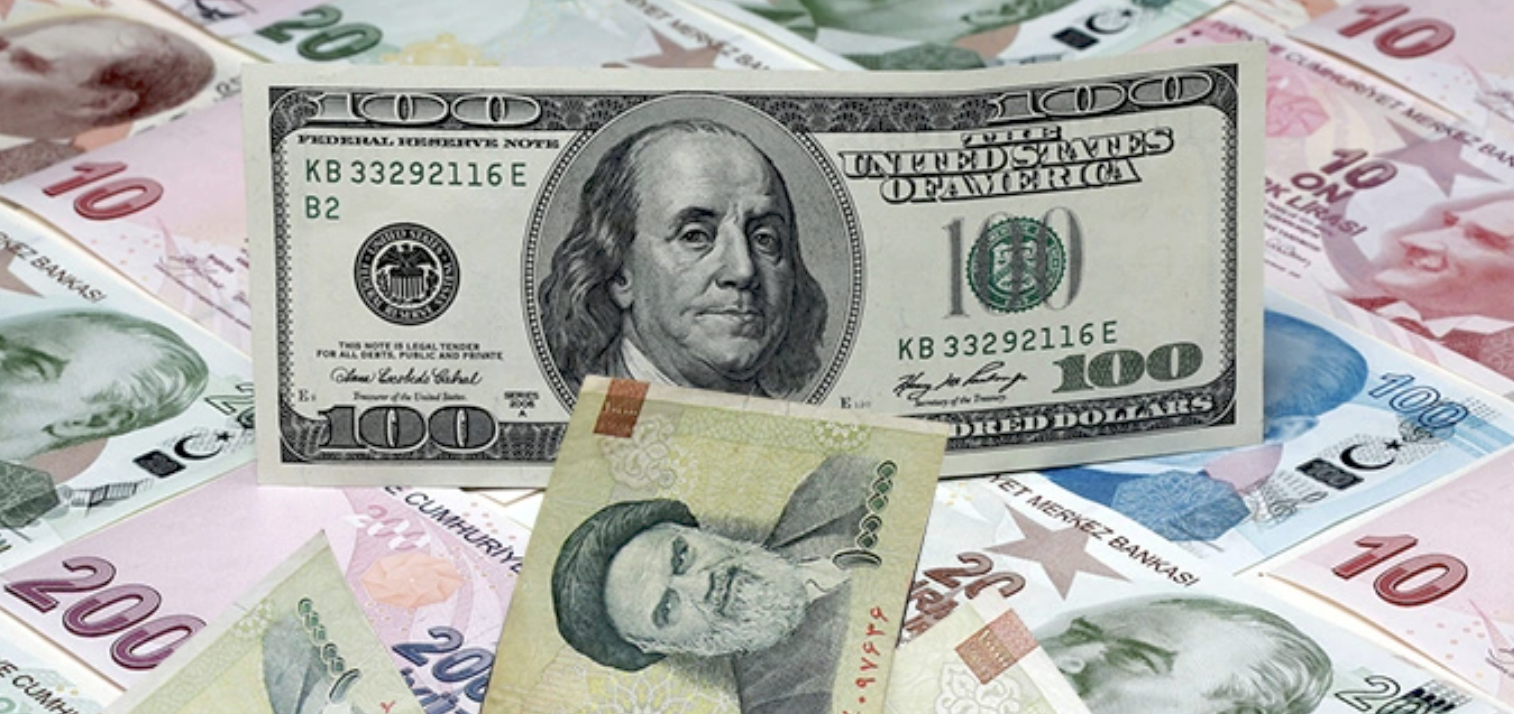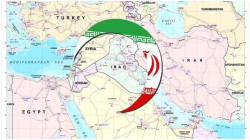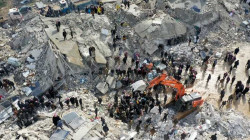Financial "Tsunami" ravages the currencies of Turkey, Syria, Lebanon, and Iran: four models of financial meltdown

Shafaq News / The currencies of Turkey, Syria, Lebanon, and Iran are staggering under a slew of overlapping external and internal factors, casting huge doubts on their capacity to recover in 2022 amid a melange of interlocking complexities.
This critical decay of the financial situation in these four states clearly puts their political and social stability in jeopardy. With the capacity of the governments to contain the economic crisis and the subsequent popular discontent that may emerge in doubt, a combination of external pressures, such as sanctions, come to further complicates the situation.
The Turkish lira
Turkey appears to be a unique model to demonstrate the complexity of the scene. The national currency plunged as much as 45% to a record low against the dollar in less than a year. Since the end of October, the Turkish lira has slid steeply losing 30% of its value with an inflation rate soaring above 21%.
The unorthodox maneuvers of the Turkish President, Recep Tayyip Erdogan, has sparkes controversy inside and outside Turkey. Erdogan has never hidden his opposition to high interest rates which he maintains - contrary to economic orthodoxy - cause inflation. He has sacked three central bank governors in three years, two of whom resisted his calls to cut rates.
Erdogan said he would lift the interest rate burden from people and urged businesses to take advantage of aggressive monetary easing since September to invest, hire and export goods.
However, three months and three rate cuts later, the lira has crashed but the president is holding firm.
Slashing 500 basis points from the interest rate to 14% has sent the country into a rapid meltdown that outstripped the 2018 currency crisis, which sparked deep but brief recession.
The collapse of the Turkish currency and the high inflation provoked mass protests in Istanbul and Ankara after the price of basic commodities, especially foodstuff, skyrocketed. In order to assuage fears, Turkish authorities say that inflation is at 21%; however, economists and opponents claim that the government is concealing the true inflation rate of 58%.
In a country where the minimum wage is roughly 2,800 Turkish liras, equivalent to only about 200 dollars, the earnings of the majority of employees and workers are no longer sufficient to cover their living expenses.
Consequently, many Turks are prompted to exchange their liras with green bills in order to preserve the value of their life savings. Similarly, business are also buying dollars to maintain the continuity of their business and sustain their profits. This dollar rush accentuates the lira's depreciation and sends the U.S. dollar exchange rates to unprecedented levels.
It is no secret that the Turkish lira is also subject to the influence of external factors with Erdogan multi-pronged foreign policy. To name some, there is the strained ties with Washington, the unfriendly standoffs with Riyadh and Abu Dhabi, Turkey's military ventures in northern Syria and Libya, the involvement in the Azeri-Armenian conflict, the brawl over energy resources in the eastern Mediterranean with Greece and France, and growing distance between Ankra with Cairo.
The crisis of the Turkish lira has its offshore impacts as well; particularly on the territories controlled by Syrian factions loyal to Ankara in northern Syria, where the locals use the Turkish lira in financial and commercial transactions. After abandoning the Syrian lira in favor of its Turkish counterpart, the fall of the latter has caused severe damage to the people's incomes and purchase power.
The Syrian pound (SYP)
To demonstrate the extent of the deterioration that has hit the Syrian currency, it is enough to point out that the dollar was equivalent to about 47 SYP about 10 years ago, i.e. at the beginning of the Syrian war. However, it is currently equivalent to about 3,500 SYP on the black market, up from more than 4,000 SYP a few months ago.
In light of the war that has raged since 2011, between government troops and armed opposition factions dominated by "jihadists" and "terrorists," the Syrian state has lost its economic viability after losing control of numerous key cities.
As soon as the flames of war began to fade, in light of a near-total international boycott of the Syrian state, except from Russia, China, and Iran, which maintained its support for Damascus militarily and economically, the administration of former U.S. President Donald Trump imposed the "Caesar's Law" that tightened the noose on any financial or economic dealings with Damascus. It deprived it of money transfer and foreign trade relations. He also hit the core of reconstruction projects that were beginning to loom, and could have contributed to ensuring the flow of foreign currencies into the country, thereby providing a certain type of monetary protection to the Syrian pound.
In an unexpected turn of events, Lebanon and its banking sector plunged into the worst crisis in its history, resulting in banks holding depositors' accounts and then imposing severe restrictions on withdrawal, particularly those open in dollars, putting additional strain on the Syrian economy.
Many people were not surprised when Syrian President Bashar al-Assad said in July that the biggest barrier to investing in Syria was Syrian funds frozen in troubled Lebanese banks, adding that estimates ranged between $40 billion and $60 billion in frozen Syrian funds in Lebanon, which was "enough to thwart an economy the size of ours."
Several companies have been formed to circumvent the sanctions and western boycott measures imposed on Damascus since the beginning of its civil war, taking advantage of the Lebanese banking system and trade movement between Beirut and Damascus, to make it easier to pay for goods imported into the Syrian market through border crossings with Lebanon.
According to experts, the failure of the Lebanese banking system has led to a blow to the Syrian pound, for which Lebanon has been a lifeline, with the United Nations putting the magnitude of losses to the Syrian economy in ten years at more than 530 billion dollars.
It was remarkable that, despite Lebanon's failing banking sector, the dollar rose strongly against the Syrian pound, reaching 5,000 SYP for the first time in the country's history, before the Syrian authorities imposed repressive measures against those who manipulate the dollar rate while selling and buying. The Syrian pound recovered slightly, reaching 3,500 SYP against the dollar.
Of course, the devaluation of the Syrian pound has had a devastating impact on large social segments, particularly thousands of families who rely on government salaries and their ability to secure food, pay electricity bills, and purchase other basic necessities.
To illustrate the magnitude of the collapse that has affected millions of Syrians, consider the employee's salary before the recent collapse, which was approximately 30,000 SYP equivalent to 600 dollars, but now, despite rising above 60,000 SYP, is only worth approximately 13 dollars.
According to experts, without a regional-international settlement of the Syrian war, it would be difficult for the Syrian pound to continue to hold out and stop its lurch, in a country where the UN World Food Programme (WFP) estimates that more than 12 million people are starving, 90% of Syrians live below the poverty line, and unemployment is more than 42%.
The Lebanese pound
No one has described the Lebanese landscape more accurately than the World Bank, which stated that Lebanon has been experiencing "one of the three worst economic crises in the world in the previous 150 years" since the fall of 2019.
The Lebanese pound has been losing value against the dollar since the beginning of 2020 when it was 1,500 pounds to one dollar, it now reached 30,000 pounds at the black market’s exchange rate. A fall that the Lebanese have never witnessed alike before.
While the state kept the minimum wage at around 700,000 pounds before the collapse, when it was equivalent to about 500 dollars, the minimum wage is now less than 30 dollars, in conjunction with the dollar's scarcity crisis, while banks have refrained from paying dollar deposits to their owners, except under strict and harsh conditions.
According to experts, one of the factors that contributed to the Lebanese pound's demise was the Central Bank's request in the summer of 2020 for banks to raise their capital by 20% in order to continue operating more steadily. This required them to impose harsh measures on depositors and their money to avoid falling directly under the control of the central bank if it continued to falter.
Experts believe that a network of mutual benefits between the Bank, politicians, and money exchange companies colluded within a network of complex mechanisms to absorb dollars from the market and citizens' pockets, to secure their interests, including the ability of banks to hold on, which contributed to strengthening the dollar price through the massive turnout, and thus to the historical collapse of the Lebanese pound.
Of course, other factors paved the way for this collapse and the Central Bank's intervention in such a painful way for hundreds of thousands of depositors. The Lebanese economy was clearly fragile, impacted by the repercussions of the Syrian war and sanctions on Damascus, state mismanagement, corruption, massive waste of resources, the disruption of the flow of Arab and Western investments to the country, and the negative economic effects of COVID-19 in 2020.
Experts also point out that Lebanon imports more than 80% of its needs from abroad, resulting in a drain on dollar resources totaling tens of billions of dollars over the last three decades, while the country lacks an export value that balances the overwhelming import movement.
The protest movement, which erupted in the fall of 2019, has dramatically weakened the confidence required for any operation to withstand the dollar, in addition to causing a lot of damage to the production wheel and securing resources for the state from various taxes and fees, due to lockdowns and the disruption of government institutions. At the time, there was a general sense that the worst is coming and that the best is to transfer the savings in the Lebanese pound to the dollar to reduce the level of their cash loss.
Among the facts that were indicative of the crisis's mismanagement and the magnitude of the collapse, official estimates indicated that Lebanon's dollar reserves before the "revolution of 2019" amounted to about 31 billion dollars, but fell within months to 16 billion dollars, while opponents claim that many big and wealthy statesmen smuggled billions of dollars from Lebanese banks abroad.
All of this has accelerated the dramatic collapse of the Lebanese pound, while big traders have used the dollar scarcity to control the prices of goods imported from abroad, raising the price of a pack of cigarettes, for example, from 1,000 pounds to 14,000 pounds today, which applies to all basic and vital goods and services, medicines, fuel, electricity, and others.
Economists almost unanimously agree that without an effective government with a bold vision to address the interlocking economic collapse, Lebanon will be unable to restore confidence in its system, and thus the confidence of investors and donors, who are first calling for broad reform measures before resuming financial offerings.
The Iranian toman
Iran's national currency has frequently experienced significant and uncontrolled fluctuations, particularly in recent years as Western sanctions, particularly those imposed by the United States, have been imposed not only on the Iranian economy, but also on hundreds of institutions, companies, and individuals, to force Tehran to make concessions regarding its nuclear program and regional influence.
The dollar's exchange rate currently ranges from 31,000 tomans, which frequently falls significantly. For example, about a year ago, it was equivalent to 32,000 tomans, but then fell to 22,000 tomans after the Central Bank of Iran was forced to inject much of the dollar into the markets to curb the collapse.
It had only been a few months since the new president, Ibrahim Raisi, committed to solving economic difficulties and halting the toman's depreciation against the dollar as a primary priority. However, records reveal that when he took office, the dollar was worth around 25,000 tomans.
The collapse of the value of the toman has had a severe impact on the lives of millions of Iranians, who, like Turks, Syrians, and Lebanese, have seen their financial savings evaporating right in front of their eyes, prompting them to buy dollars, gold coins, and real estate in order to save as much as they can. A rush that has naturally contributed to increasing the dollar's value.
The elements and factors that cause the collapse of Turkey's, Syria's, Lebanon's, and Iran's national currencies are similar and unique, but the bottom line is that the economies of these countries are intertwined and affected by each other and regional developments, particularly the security and military unrest that is taking place here and there, as well as the developments of the Iranian nuclear file in Vienna.
The question is whether a full détente in one of those countries will have a direct impact on the other three, and how favorable this change will be. It is critical to keep an eye on the potential political ramifications of the Turkish, Syrian, Lebanese, and Iranian national currencies continued passage through the dark tunnel, when it will end, and, most crucially, how much it will cost.





